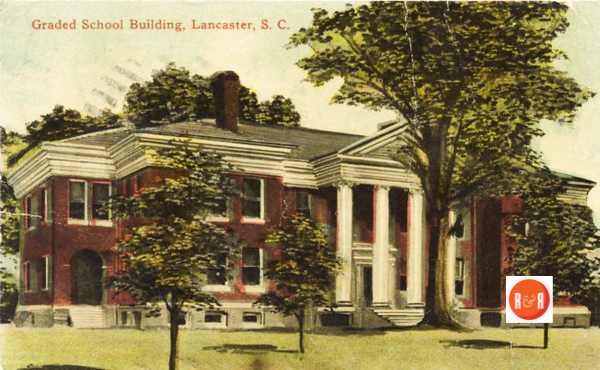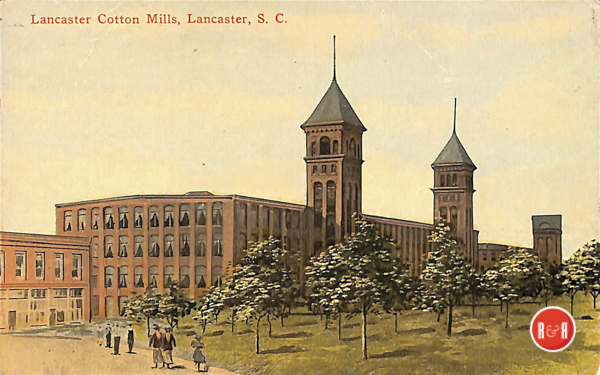The Rock Hill Herald reported on Feb. 16, 1888 – “A commission was issued by the Sec. of State to the Lancaster Cotton Mills to issue stock up to $100,000.” On May 24, 1888 the paper further reported – “The stock holders of the Lancaster Cotton Mills held a meeting last Tuesday night. After discussion, they decided to disorganize the mill. The installment plan of selling stock proved to be too slow. About $2,000. had been paid into the Treasurer which will be returned.”
On May 15, 1895 the Yorkville Enquirer reported – “The town of Lancaster has the cotton mill fever. They propose a $150,000. plant. The incorporators are: LeRoy Springs, W.T. Gregory, Earnest Moore, J.W. Heath, M.P. Crawford, L.C. Payseur, T.Y. Williams, and W.C. Thompson.”
In South Carolina alone, from 1894 to 1903 the firm designed and built sixteen mills, including four that W. B. Smith Whaley owned and managed himself in Columbia–Richland (1894–1895), Granby (1896), Capital City (1899), and Olympia (1899–1900). Other textile mills included the Courtenay Mill in Newry (1893–1894), the Enterprise Mill in Orangeburg (1896), the Warrenville Mill in Aiken County (1897), the Buffalo Mill in Union County (1899), the Lancaster Mills for the textile magnate Leroy Springs (1900), the DeKalb Mill in Camden (1900), and the Glenn-Lowry Mill in Whitmire (1900). In 1899–1900 Whaley built his masterpiece, the 2,400-loom, 104,000-spindle, four-story Olympia Mill near Columbia. Courtesy of the SC Encyclopedia Website
In April of 1915, the “Greater Sheesley’s Shows” came to Lancaster. J.O. Redding of Somervllle, Massachusetts was flying….” Pettus
City Directories and History: The Herald reported on Aug. 14, 1895 – “That W. G. Adams has been employed to supervise the construction of the Lancaster Cotton Mill. The building will be 80 – 200 ft., with three stories and a basement.”
The Herald reported on July 19, 1899 – “Mr. F.T. Wood has returned to Rock Hill from Lancaster, where he has finished his contract to make a million brick for Mr. LeRoy Springs.”
The Rock Hill Herald on Sept. 30., 1899 carried a report from the Lancaster Enterprise, “that Col. LeRoy Springs is raising $1.- 1.5 million dollars for a big mill. He has made most financial arrangements but they are conditioned on raising a certain amount of money in Lancaster. He hopes to raise $75,000. – $100,000. in Lancaster in order to get Northern people to finance 9-10 times that amount.”
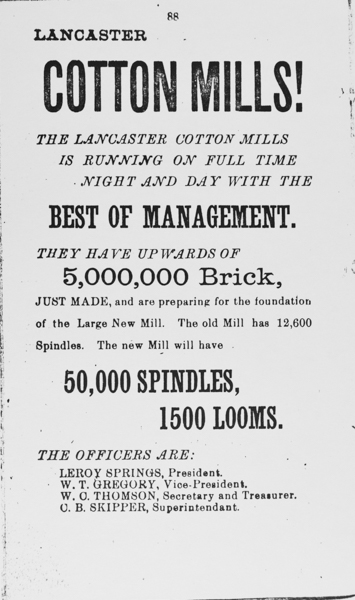
Courtesy of the AFLLC – Pettus Collection – 2020 / Lancaster Cotton Mill ad, ca. 1900
The RH Herald reported on June 16, 1900 – “The Lancaster Cotton Mill will be increased in size from 12,000 spindles to 62,000 spindles and from 500 looms to 1,590 looms. The present mill building will be greatly enlarged. Colonel Springs is the chief promoter of this skem and is said to have already purchased most of the machinery. This project will make Lancaster one of the leading manufacturing cities in the state. It is proposed to power the machinery by a new company at or near Landsford on the Catawba River.”
On July 25, 1900 the Herald reported – “The work is about to commonsense on the enlargement of the cotton mill at Lancaster. A contract for 4 million brick has been awarded to Mr. Tanner of Charlotte. The mill will be run by electricity from a new dam at Landsford, which could also supply all of Lancaster, Rock Hill and Chester.”
The Rock Hill Herald reported on July 12, 1902 – “A strong storm in Lancaster recently damaged the roof of the new mill under construction. It also damaged the framework and chimneys of a new house being constructed for Mr. Glenmore B. Barron, formerly of Rock Hill. This house is being built by contractor Starnes. A seven room house owned by Mr. Barron and occupied by W.B. Culp was moved from its foundation and heavily damaged. Nine building owned by Sheriff Hunter were damaged or destroyed including three new tenant houses, two cottages, and four store rooms.”
The Rock Hill Herald on April 29, 1903 reported, “The Lancaster Mill is starting their 1,600 new looms and has installed the largest engine in the state.”
The Rock Hill Herald reported on July 4, 1903 – “T.N. Balfour went to Lancaster yesterday to strip the engine at Lancaster Cotton Mill.”
The Lancaster News reported on Feb. 12, 1932 – “The Lancaster Mill Village now has water and electric light. The electricity was completed last Saturday.”
WILLIAM G. ADAMS
William Graham Adams was born about 1856 in Lancaster County, the son of John H. Adams and Mary Graham Adams. In the 1860 Census, the family is shown as living in Lancaster County. W. G. was four years old, and he had a sister named Sarah and a brother named John, both older. Also in the household were Elizabeth Adams, age 65, who was born in Ireland about 1795 and Joseph Adams, aged 39. Both Joseph Adams and John H. Adams was farmers. It is likely that they were brothers and that Elizabeth was their mother.
W. G. Adams lived in Rock Hill most of his adult life, and his home was at 418 Hampton Street from at least 1908 to his death in 1939. He was a building contractor known for building a number of important homes and public buildings in Rock Hill and other communities. Although he lived in Rock Hill, he also had a business office in Camden for a number of years.
We have documentation on a number of properties built by Mr. Adams. Some of the buildings constructed in Rock Hill included the Rock Hill Graded School (1887), the Southern Hotel (originally the Carolina Hotel built in 1888 on Main Street in Rock Hill), McLauren Hall at Winthrop University, homes for John T. Roddey in 1889 (404 East Main Street and 219 Oakland Avenue), the Poag/Robbins House (built in 1889 on Main Street and later moved to 130 Reid Street), and the W. B. Wilson House at 434 Charlotte Avenue in 1895 (now the Oratory). In Lancaster, he built the Lancaster Cotton Mill in 1895. In Chester, he built the City Hall and Opera House in 1890-91.
Mr. Adams married Margaret Crowell and they had at least three children, Mrs. Mamie B. Murray of Rock Hill, Mrs. John R. McDonald of Greenville, and William C. Adams of Ozark, Alabama. Mr. Adams and his family were members of St. Johns Methodist Church in Rock Hill.
W. G. Adams died on March 13, 1939 at his home and was buried at Laurelwood Cemetery in Rock Hill. The funeral service was held at Bass Funeral Home with the Rev. J. F. Lupo, pastor of St. Johns Methodist Church officiating. The active pallbearers were L. S. Starnes, P. R. Robertson, F. D. Marshall, J. Frank Smith, Earl Hearn, and J. C. Houser. Mrs. Adams died on November 25, 1941.

Image courtesy of the L. Pettus Collection – 2015
Sources: The obituary for W. G. Adams appeared in the Rock Hill Herald on March 14, 1939, and was used for much of the information in this article. The information on buildings constructed by Mr. Adams was gathered from various issues of the Rock Hill Herald. Written and contributed to Roots and Recall by Paul Gettys – 2016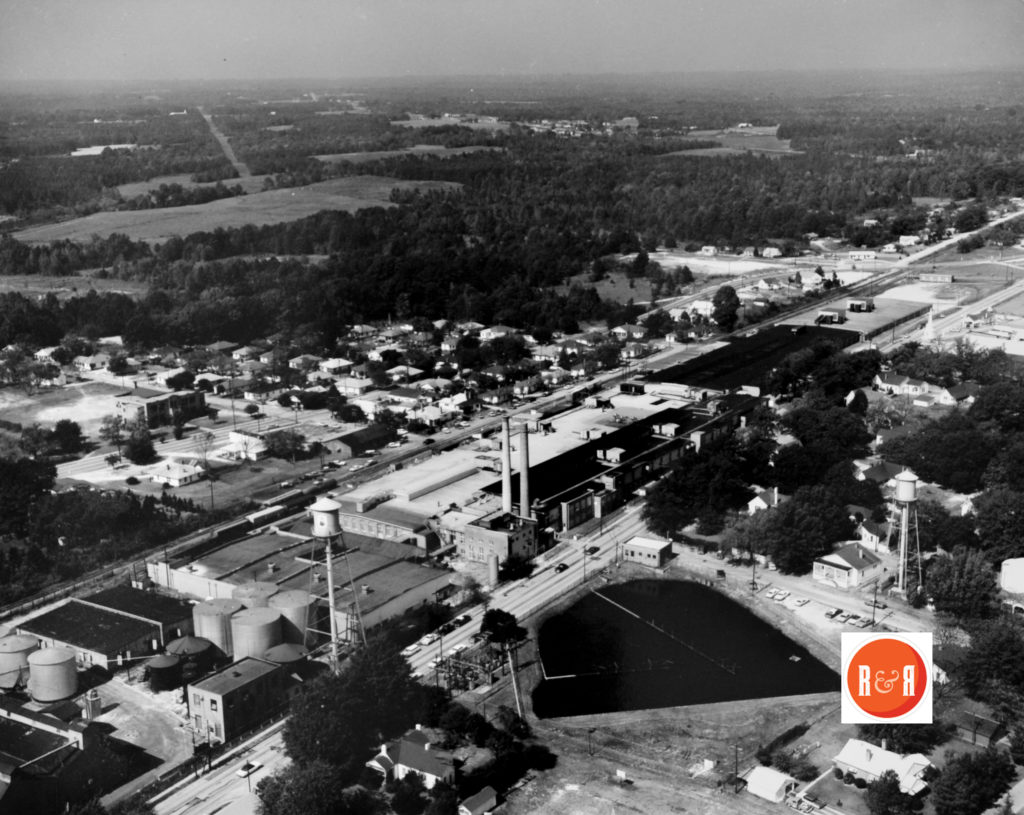
The Herald reported on Feb. 5, 1896 – “It is likely that when the Lancaster Mill gets in operation, a good many who came from the eastern part of the state to work at a the Standard Mill will move to Lancaster.”
The Herald reported on Feb. 8, 1896 – (Quoting the Lancaster Ledger) – “Work on the Lancaster Mill is progressing rapidly. The fourth and last story is now being completed. The building is 213 – 80 ft., and the walls at the foundation are four feet thick. Forty cottages will be completed soon, each with five rooms.”
The Herald reported on Feb. 12, 1896 that Mr. W. G. Adams came over from Lancaster and spend Sunday at home in Rock Hill. Work on the Lancaster Mill is moving along.
The Herald reported on June 13, 1896 – “Mr. Henry Knox, and hydraulic engineer, is putting in artesian well on the property of the mill.”
The Herald reported on Feb. 23, 1901 – “Mr. T.C. Thompson, the contractor who had done a great deal of work at Winthrop College has the contract to erect Lancaster’s million dollar mill and has gone there with his bookkeeper, C.A. Hutchison and his stenographer, Ms. Love.”
The Rock Hill Herald reported on May 1, 1901 – “Brick laying has commenced on Lancaster’s million dollar cotton mill.”
The Herald quoting the Fort Mill Times on Sep. 27, 1902 – “The new machinery for Col. Leroy Spring’s big million dollar mill in Lancaster is being put in place rapidly, and is expected the mill will be in full operation by Dec. 1.
The Record reported on March 30, 1908 – “Mr. G.L. Dobson, who has been connected with the Lancaster Mills for some time, has resigned and taken a position with the Ashe Brick Works in Rock Hill.”
MCCORKLES OF YORK, S.C. – By Louise Pettus
Paul Grier McCorkle, during the years 1920-1934, was widely known as the “Blind Coroner of York County.”
McCorkle was born in Yorkville, the county seat, in 1863. At the time his father, William Hart McCorkle was captain of “A” Co., 12th Reg’t, SC Volunteers and later was advanced to the rank of colonel. His mother was Elva Grier McCorkle, a native of the Steel Creek community of Mecklenburg County. Young Paul McCorkle attended Kings Mountain Academy in Yorkville, a prep school for the Citadel. What he did immediately after graduation we do not know, but when 27 he went to work for Leroy Springs in his mercantile store in Lancaster. He also lived in the Springs home (the home still stands in downtown Lancaster where it serves as the Lancaster City Hall).
When Colonel Springs built the Lancaster Cotton Mills in 1895 he made McCorkle his head cotton classer. Springs had organized the Leroy Springs and Company, a cotton shipping company in 1886. With the building of the cotton mill, Springs expanded and built more offices . McCorkle was placed in charge of the cotton buying operation with offices in Rock Hill, Chester and Charlotte, as well as Lancaster. McCorkle played an important role in the expansion of Leroy Springs and Company. It had been small in the beginning but expanded until it is said that one year the company shipped more cotton into Liverpool, England than any other firm in the world. Springs had seats on both the New York and New Orleans Cotton Exchanges and was a powerful force in that world.
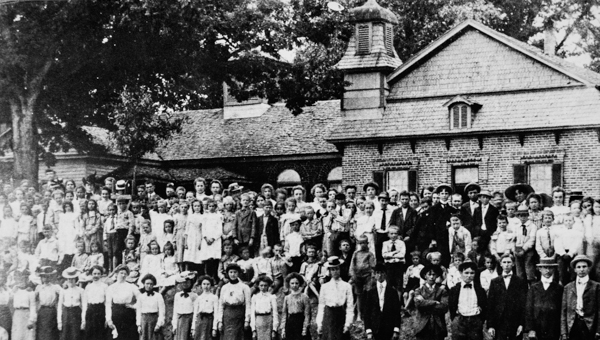
Courtesy of the Lancaster Co Pictorial History by Bishop and Pettus – 1984

At the height of his career, in mid-June 1905, Paul McCorkle was driving a buggy in Chester when his horse was startled by a small dog. The horse panicked and ran. McCorkle kept control until the horse swerved on a bank, placing the horse on a higher level than the buggy occupants. The horse twice kicked McCorkle in the face. The face’s small bones were shattered and, worse, McCorkle was permanently blinded.
Never did McCorkle allow blindness to stop him. He operated Colonel Springs cotton classing office in Chester for 6 years before returning to York. He also operated as a grain merchant on his own for some time. Springs did not forget him and sent McCorkle a regular check (no social security at that time). When Leroy Springs died in 1931, his son, Col. Elliott White Springs, continued the checks for the remainder of McCorkle’s life.
Two wealthy Charlotte business men, E. D. Latta and John M. Scott, were admirers of McCorkle and sent him money. Latta left McCorkle a bequest in his will. McCorkle and his white cane were a familiar sight on the streets of York. He was a handsome man, equally recognizable with his white hair and “a booming voice and laugh.” Described as “nonchalant” he negotiated the streets and business houses with such ease that without the cane many would not have suspected that he was blind. One time a car hit him and McCorkle brushed off the accident with the statement that it was his own fault – that he was not watching where he was going.
McCorkle performed so well as a coroner that the man who replaced him as coroner was also blind. McCorkle married Eileen Lemmond who was 15 years younger than he. They had two sons. The older lived only a few months. The second boy, William Hart McCorkle, named for his grandfather, was born in 1900. He was educated at the Citadel and Union Theological Seminary in Richmond. Dr. William H. McCorkle served as a U. S. Navy chaplain from 1942-1945. He emerged from World War II as the most highly decorated chaplain in the history of the U. S. armed services. In 1963, “Billy” McCorkle received the highest honor a Presbyterian minister can receive — Moderator of the General Assembly. (Printed in York Observer, 23 September 1995.)
IMAGE GALLERY OF THE MILL – Designed by W. B. Smith Whaley of Columbia, S.C. and built by contractor Wm. G. Adams of Rock Hill, S.C.
- Images courtesy of the AFLLC Collection – 2017
Stay Connected
Explore history, houses, and stories across S.C. Your membership provides you with updates on regional topics, information on historic research, preservation, and monthly feature articles. But remember R&R wants to hear from you and assist in preserving your own family genealogy and memorabilia.
Visit the Southern Queries – Forum to receive assistance in answering questions, discuss genealogy, and enjoy exploring preservation topics with other members. Also listed are several history and genealogical researchers for hire.
User comments welcome — post at the bottom of this page.
Please enjoy this structure and all those listed in Roots and Recall. But remember each is private property. So view them from a distance or from a public area such as the sidewalk or public road.
Do you have information to share and preserve? Family, school, church, or other older photos and stories are welcome. Send them digitally through the “Share Your Story” link, so they too might be posted on Roots and Recall.
Thanks!


